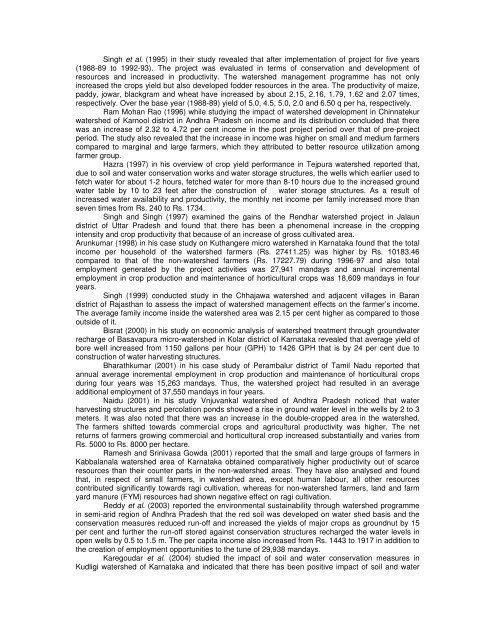Master of Science - ETD | Electronic Theses and Dissertations of ...
Master of Science - ETD | Electronic Theses and Dissertations of ...
Master of Science - ETD | Electronic Theses and Dissertations of ...
Create successful ePaper yourself
Turn your PDF publications into a flip-book with our unique Google optimized e-Paper software.
Singh et al. (1995) in their study revealed that after implementation <strong>of</strong> project for five years<br />
(1988-89 to 1992-93). The project was evaluated in terms <strong>of</strong> conservation <strong>and</strong> development <strong>of</strong><br />
resources <strong>and</strong> increased in productivity. The watershed management programme has not only<br />
increased the crops yield but also developed fodder resources in the area. The productivity <strong>of</strong> maize,<br />
paddy, jowar, blackgram <strong>and</strong> wheat have increased by about 2.15, 2.16, 1.79, 1.62 <strong>and</strong> 2.07 times,<br />
respectively. Over the base year (1988-89) yield <strong>of</strong> 5.0, 4.5, 5.0, 2.0 <strong>and</strong> 6.50 q per ha, respectively.<br />
Ram Mohan Rao (1996) while studying the impact <strong>of</strong> watershed development in Chinnatekur<br />
watershed <strong>of</strong> Karnool district in Andhra Pradesh on income <strong>and</strong> its distribution concluded that there<br />
was an increase <strong>of</strong> 2.32 to 4.72 per cent income in the post project period over that <strong>of</strong> pre-project<br />
period. The study also revealed that the increase in income was higher on small <strong>and</strong> medium farmers<br />
compared to marginal <strong>and</strong> large farmers, which they attributed to better resource utilization among<br />
farmer group.<br />
Hazra (1997) in his overview <strong>of</strong> crop yield performance in Tejpura watershed reported that,<br />
due to soil <strong>and</strong> water conservation works <strong>and</strong> water storage structures, the wells which earlier used to<br />
fetch water for about 1-2 hours, fetched water for more than 8-10 hours due to the increased ground<br />
water table by 10 to 23 feet after the construction <strong>of</strong> water storage structures. As a result <strong>of</strong><br />
increased water availability <strong>and</strong> productivity, the monthly net income per family increased more than<br />
seven times from Rs. 240 to Rs. 1734.<br />
Singh <strong>and</strong> Singh (1997) examined the gains <strong>of</strong> the Rendhar watershed project in Jalaun<br />
district <strong>of</strong> Uttar Pradesh <strong>and</strong> found that there has been a phenomenal increase in the cropping<br />
intensity <strong>and</strong> crop productivity that because <strong>of</strong> an increase <strong>of</strong> gross cultivated area.<br />
Arunkumar (1998) in his case study on Kuthangere micro watershed in Karnataka found that the total<br />
income per household <strong>of</strong> the watershed farmers (Rs. 27411.25) was higher by Rs. 10183.46<br />
compared to that <strong>of</strong> the non-watershed farmers (Rs. 17227.79) during 1996-97 <strong>and</strong> also total<br />
employment generated by the project activities was 27,941 m<strong>and</strong>ays <strong>and</strong> annual incremental<br />
employment in crop production <strong>and</strong> maintenance <strong>of</strong> horticultural crops was 18,609 m<strong>and</strong>ays in four<br />
years.<br />
Singh (1999) conducted study in the Chhajawa watershed <strong>and</strong> adjacent villages in Baran<br />
district <strong>of</strong> Rajasthan to assess the impact <strong>of</strong> watershed management effects on the farmer’s income.<br />
The average family income inside the watershed area was 2.15 per cent higher as compared to those<br />
outside <strong>of</strong> it.<br />
Bisrat (2000) in his study on economic analysis <strong>of</strong> watershed treatment through groundwater<br />
recharge <strong>of</strong> Basavapura micro-watershed in Kolar district <strong>of</strong> Karnataka revealed that average yield <strong>of</strong><br />
bore well increased from 1150 gallons per hour (GPH) to 1426 GPH that is by 24 per cent due to<br />
construction <strong>of</strong> water harvesting structures.<br />
Bharathkumar (2001) in his case study <strong>of</strong> Perambalur district <strong>of</strong> Tamil Nadu reported that<br />
annual average incremental employment in crop production <strong>and</strong> maintenance <strong>of</strong> horticultural crops<br />
during four years was 15,263 m<strong>and</strong>ays. Thus, the watershed project had resulted in an average<br />
additional employment <strong>of</strong> 37,550 m<strong>and</strong>ays in four years.<br />
Naidu (2001) in his study Vnjuvankal watershed <strong>of</strong> Andhra Pradesh noticed that water<br />
harvesting structures <strong>and</strong> percolation ponds showed a rise in ground water level in the wells by 2 to 3<br />
meters. It was also noted that there was an increase in the double-cropped area in the watershed.<br />
The farmers shifted towards commercial crops <strong>and</strong> agricultural productivity was higher. The net<br />
returns <strong>of</strong> farmers growing commercial <strong>and</strong> horticultural crop increased substantially <strong>and</strong> varies from<br />
Rs. 5000 to Rs. 8000 per hectare.<br />
Ramesh <strong>and</strong> Srinivasa Gowda (2001) reported that the small <strong>and</strong> large groups <strong>of</strong> farmers in<br />
Kabbalanala watershed area <strong>of</strong> Karnataka obtained comparatively higher productivity out <strong>of</strong> scarce<br />
resources than their counter parts in the non-watershed areas. They have also analysed <strong>and</strong> found<br />
that, in respect <strong>of</strong> small farmers, in watershed area, except human labour, all other resources<br />
contributed significantly towards ragi cultivation, whereas for non-watershed farmers, l<strong>and</strong> <strong>and</strong> farm<br />
yard manure (FYM) resources had shown negative effect on ragi cultivation.<br />
Reddy et al. (2003) reported the environmental sustainability through watershed programme<br />
in semi-arid region <strong>of</strong> Andhra Pradesh that the red soil was developed on water shed basis <strong>and</strong> the<br />
conservation measures reduced run-<strong>of</strong>f <strong>and</strong> increased the yields <strong>of</strong> major crops as groundnut by 15<br />
per cent <strong>and</strong> further the run-<strong>of</strong>f stored against conservation structures recharged the water levels in<br />
open wells by 0.5 to 1.5 m. The per capita income also increased from Rs. 1443 to 1917 in addition to<br />
the creation <strong>of</strong> employment opportunities to the tune <strong>of</strong> 29,938 m<strong>and</strong>ays.<br />
Karegoudar et al. (2004) studied the impact <strong>of</strong> soil <strong>and</strong> water conservation measures in<br />
Kudligi watershed <strong>of</strong> Karnataka <strong>and</strong> indicated that there has been positive impact <strong>of</strong> soil <strong>and</strong> water
















